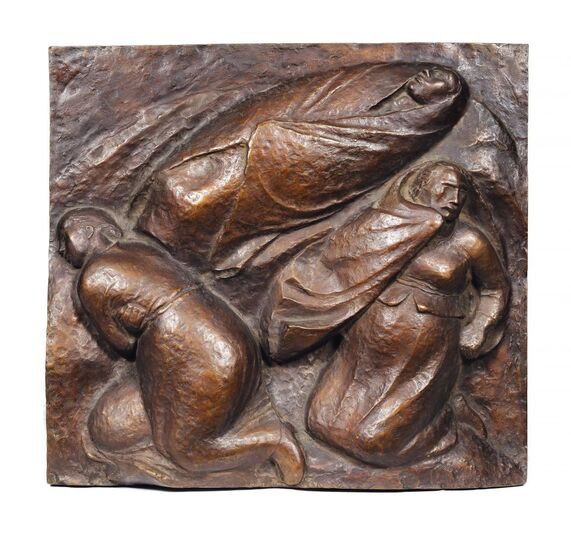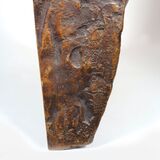The Abandoned
Ernst Barlach (Wedel/Holst. 1870 - Rostock 1938)

Lot-No. 411
Designed 1912, made in bronze after 1983. Bronze relief, brown patinated. 59,5 x 65 cm. Lower edge right sign. E. Barlach, foundry stamp H. NOACK BERLIN, numbered copy 1/6. Group of two kneeling and one reclining woman on a hillside - Literature: Laur (cat. rais. 199) mentions 6 numbered casts; during Barlach's lifetime, no casts were made in bronze, only one was made in wood in 1913. Other locations: Ernst Barlach Gesellschaft (Museums Ratzeburg, Wedel) - Provenance: From the artist's family - German sculptor, writer and illustrator. B. studied 1888-95 at the Hamburg Kunstgewerbeschule and at the Dresden academy. He lived in Paris for two years before working as ceramicist in Hamburg, among others for the Altona manufactory Mutz. A journey to Russia became distinctive for his work. He first exhibited sculptures from Russian folk life at the Berlin secession in 1907. Subsequently he received many important public commissions. B. was very much pressurized by the Nazis, a. many of his works were seized or destroyed. Today he is appreciated as one of the most important sculptors of the 20th cent. Mus.: Hamburg (Ernst Barlach Haus), Nuremberg (Germanisches Nationalmuseum), Schwerin a. others. Lit.: Schult (cat. rais.) a. others.
Ernst Barlach: The Abandoned
Ernst Barlach (Wedel/Holst. 1870 - Rostock 1938)
The Abandoned
Lot-No. 411
Designed 1912, made in bronze after 1983. Bronze relief, brown patinated. 59,5 x 65 cm. Lower edge right sign. E. Barlach, foundry stamp H. NOACK BERLIN, numbered copy 1/6. Group of two kneeling and one reclining woman on a hillside - Literature: Laur (cat. rais. 199) mentions 6 numbered casts; during Barlach's lifetime, no casts were made in bronze, only one was made in wood in 1913. Other locations: Ernst Barlach Gesellschaft (Museums Ratzeburg, Wedel) - Provenance: From the artist's family - German sculptor, writer and illustrator. B. studied 1888-95 at the Hamburg Kunstgewerbeschule and at the Dresden academy. He lived in Paris for two years before working as ceramicist in Hamburg, among others for the Altona manufactory Mutz. A journey to Russia became distinctive for his work. He first exhibited sculptures from Russian folk life at the Berlin secession in 1907. Subsequently he received many important public commissions. B. was very much pressurized by the Nazis, a. many of his works were seized or destroyed. Today he is appreciated as one of the most important sculptors of the 20th cent. Mus.: Hamburg (Ernst Barlach Haus), Nuremberg (Germanisches Nationalmuseum), Schwerin a. others. Lit.: Schult (cat. rais.) a. others.




